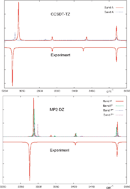The ab initio assigning of the vibrational probing modes of tryptophan: linear shifting of approximate anharmonic frequencies vs. multiplicative scaling of harmonic frequencies†
Abstract
To gain insight into the prospects for a few-dimensional ab initio quantum-mechanical description of the vibrational motions of conformationally flexible molecular systems, the NH-, NH2-, CO- and OH-stretching and COH-bending vibrations of the most stable tryptophan conformations have been probed using simple one- and two-dimensional anharmonic Hamiltonians and potential energy functions evaluated by means of the standard RI-MP2, CCSD(T) and DFT-D quantum chemical procedures. Although strongly dependent on the procedure used, the calculated vibrational spectral patterns have been found to be in a robust one-to-one harmony with their experimental counterparts, thus proving the adequacy of the theory used for the reliable assignment of the experimental data. Therefore, the approach appears to be a suitable tool for assigning the vibrational probing modes even of systems which are too large to be tractable by the standard normal-coordinate analysis.


 Please wait while we load your content...
Please wait while we load your content...